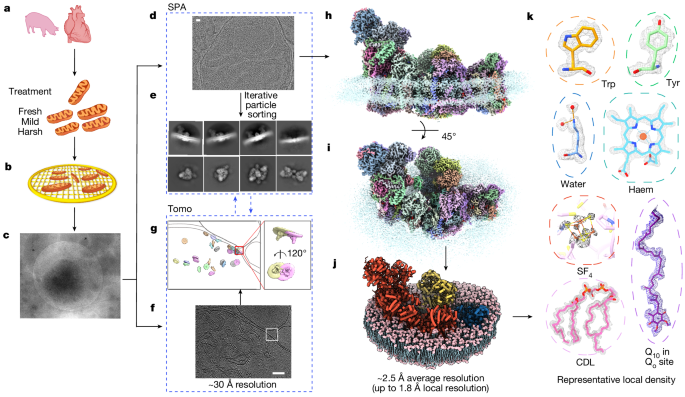High-resolution Cryo-EM Structures of Mammalian Respiratory Supercomplexes in their Native Mitochondrial Environment
Core Concepts
Cryo-EM imaging of porcine mitochondria reveals the native structures of various respiratory supercomplex assemblies and their dynamic intermediates, providing insights into the molecular mechanisms of oxidative phosphorylation.
Abstract
The article presents a high-resolution cryo-electron microscopy (cryo-EM) study of the native structures of respiratory supercomplexes in porcine mitochondria. The key findings are:
Four main supercomplex organizations were identified: I1III2IV1, I1III2IV2, I2III2IV2 and I2III4IV2, which can potentially expand into higher-order arrays on the inner mitochondrial membranes.
These supercomplexes are largely formed through "protein-lipid-protein" interactions, which substantially impact the local geometry of the surrounding membranes.
The in situ structures captured numerous reactive intermediates within the respiratory supercomplexes, shedding light on the dynamic processes of the ubiquinone/ubiquinol exchange mechanism in complex I and the Q-cycle in complex III.
Structural comparison of supercomplexes from mitochondria under different conditions suggests a possible correlation between the conformational states of complexes I and III, likely in response to environmental changes.
By preserving the native membrane environment, this approach enables structural studies of mitochondrial respiratory supercomplexes at high resolution, from atomic-level details to the broader subcellular context.
High-resolution in situ structures of mammalian respiratory supercomplexes - Nature
Stats
Four main supercomplex organizations were identified: I1III2IV1, I1III2IV2, I2III2IV2 and I2III4IV2.
The diverse supercomplexes are largely formed by 'protein–lipids–protein' interactions.
The in situ structures captured numerous reactive intermediates within the respiratory supercomplexes.
Quotes
"These diverse supercomplexes are largely formed by 'protein–lipids–protein' interactions, which in turn have a substantial impact on the local geometry of the surrounding membranes."
"Our in situ structures also capture numerous reactive intermediates within these respiratory supercomplexes, shedding light on the dynamic processes of the ubiquinone/ubiquinol exchange mechanism in complex I and the Q-cycle in complex III."
Key Insights Distilled From
by Wan Zheng,Pe... at www.nature.com 05-29-2024
https://www.nature.com/articles/s41586-024-07488-9
Deeper Inquiries
How do the conformational changes in respiratory complexes I and III observed under different conditions relate to the overall energy production and efficiency of the mitochondrial oxidative phosphorylation system?
The conformational changes in respiratory complexes I and III play a crucial role in the efficiency of the mitochondrial oxidative phosphorylation system. These changes are often responsive to environmental conditions and metabolic demands, affecting the flow of electrons and ultimately ATP production. For instance, alterations in the conformation of complex I can impact the ubiquinone/ubiquinol exchange mechanism, which is essential for electron transfer and proton pumping. Similarly, changes in the conformation of complex III can influence the Q-cycle, which is involved in generating the proton gradient necessary for ATP synthesis. By adapting their structures in response to different conditions, these complexes optimize the efficiency of electron transport and ATP generation, ensuring the overall energy production of the mitochondria.
What are the potential implications of the diverse supercomplex organizations and their membrane-shaping properties on mitochondrial dynamics and function?
The diverse supercomplex organizations identified in this study have significant implications for mitochondrial dynamics and function. These supercomplexes, formed by intricate protein-lipid interactions, not only facilitate electron transport chain efficiency but also play a role in shaping the mitochondrial inner membrane. The membrane-shaping properties of these supercomplexes can impact the curvature and organization of the inner membrane, influencing processes such as cristae formation and mitochondrial dynamics. Changes in membrane architecture can affect the spatial organization of respiratory complexes, optimizing their interactions and enhancing overall respiratory efficiency. Furthermore, alterations in supercomplex organization may impact mitochondrial fusion and fission dynamics, influencing mitochondrial morphology and function. Understanding these implications can provide insights into how mitochondrial structure and function are intricately linked.
Could the insights from this study on the native structures of respiratory supercomplexes be leveraged to develop new therapeutic strategies for mitochondrial diseases or metabolic disorders?
The insights gained from studying the native structures of respiratory supercomplexes hold great potential for the development of new therapeutic strategies for mitochondrial diseases and metabolic disorders. By elucidating the high-resolution structures of these supercomplexes in their native states, researchers can uncover key molecular mechanisms underlying mitochondrial function and dysfunction. This knowledge can be leveraged to design targeted interventions that modulate the activity of respiratory complexes, restore proper electron transport chain function, and enhance ATP production. Additionally, understanding the impact of supercomplex organization on mitochondrial dynamics can lead to novel approaches for treating conditions associated with mitochondrial dysfunction, such as neurodegenerative diseases and metabolic disorders. By harnessing the structural insights provided by this study, researchers can pave the way for innovative therapeutic interventions that target mitochondrial respiratory supercomplexes to address a wide range of health conditions.
0
